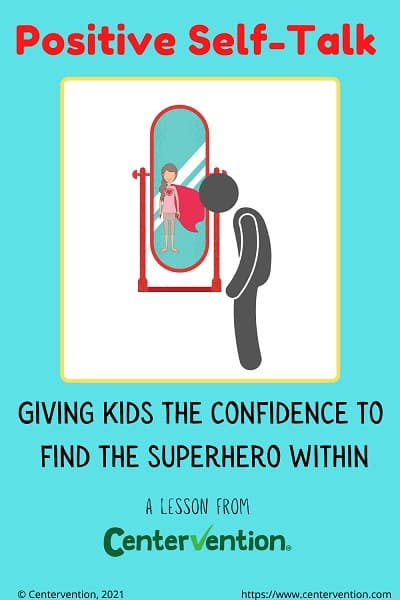Positive thinking is a psychological framework for embracing optimism that has gained attention in recent years. Research suggests that a positive mindset lowers stress and boosts immunity, and that those who practice positive thinking strategies experience increased joy. There are books and graduate programs devoted to the science behind it, and really, it just feels good to find hope in challenging situations.
Still, humans naturally experience a range of emotions, so when we face fears, mistakes, or other tricky situations it can be understandable to slip into thinking patterns that may include negative self-talk. Dr. Clifford Lazarus explains that, “Self-talk, for an unfortunately large number of people, consists of telling themselves what’s wrong with them. They often repeat such statements as, I’m stupid, I’m selfish, I sound like a fool, (etc.).” And while owning up to one’s mistakes is an important skill for both adults and students, Dr. Lazarus explains that this kind of depreciating language can lead to long term depression or anxiety. With a little practice and effort, however, he adds that, “Happily, the converse is also true [and] positive self-talk will tend to achieve desirable outcomes and generate good feelings.”
There are many strategies for helping students shift negative thinking through practicing positive self talk, and we’ve based this lesson on a Hall of Heroes game scene that does just that. In the game, superhero students are challenged by their Shadow Self, a figure of dread and doubt whose negative self-talk must be overpowered by positivity in order to advance! The activities below will introduce your students to the practice of reframing negative thinking, preparing them to defeat their Shadow Selves both in the game and real life!
Recommended Grade Level: Elementary and Middle
SEL Skill(s): Emotion Regulation
Duration: 30 minutes
Materials:
Positive Self Talk Lesson Instructions
Mind-Body Warm Up: Gather students and spread them far enough so they can engage in light stretching without touching. Say:
“Today we are going to imagine we are superheroes and have a stretch before we start the lesson.”
With both hands, reach down to touch the toes, then come back up. As you rise, place one hand on hip and the other fisted in the air. Lift one foot up into “Superhero Stretch” before placing the foot back down and touching the toes again. Repeat 10 times.
Prompt: After the exercise, notice the physical energy change, saying:
“My body feels warm and powerful, like a superhero! That happens when you exercise, but can also happen when we feel good, or positive, about something we are doing well. For example, I feel powerful when I finish a tricky jigsaw puzzle. When do you feel like a superhero?”
Accept answers and continue:
“Sometimes when things are hard though, I might feel the opposite, or negative. Instead of feeling like a superhero, I might doubt myself and say things that aren’t very nice to myself, like‘You can’t do it,” or‘You’re not smart.’ That’s called negative self-talk. Raise your hand if that’s ever happened to you.”
Tell students that often when they have a negative self-thought it’s because they are scared and are letting worry take over, but that if they think it through a bit, they can replace the negative thoughts with positive ones that will help them learn and grow. Say,
“If there’s a puzzle and I can’t figure it out, instead of thinking I’m not smart or I’ll never get it, I can stop and take breaths and think things like‘This is a tricky puzzle, but maybe I can take a break, try a new piece, or invite a friend to help so we can solve it together.’ By thinking in ways that are calming and helpful, you are always a superhero, even when things seem hard.”
Practice: Make a chart with 3 columns: Challenge, Negative Thought, Positive Self-Talk
Tell students you will write a common challenge on the chart. They will turn and talk to a partner about a negative thought they might have about the situation, then come up with positive self-talk to overcome the doubt.
Choose from the following list of common challenges to continue, or come up with some on your own:
- Meeting new people
- Trying a new food
- Going to a new place
- Getting ready for school
- Trying a new activity
Challenge: Provide students with a Positive Self Talk worksheet. Explain that a Shadow Self is what lurks behind you, trying to trick you into negative thinking. Working alone or in pairs, challenge students to reference the chart as they try to reverse the negative thoughts of the Shadow Self.
Reflect: Regroup and have students share their different answers from the paper. You may have them give a thumbs up each time someone shares a response similar to theirs. Invite them to discuss any problematic or repetitive negative self talk they have struggled with before, and as a team help plan positive mantras to defeat the Shadows.
Additional Resources
Related Lessons and Programs
